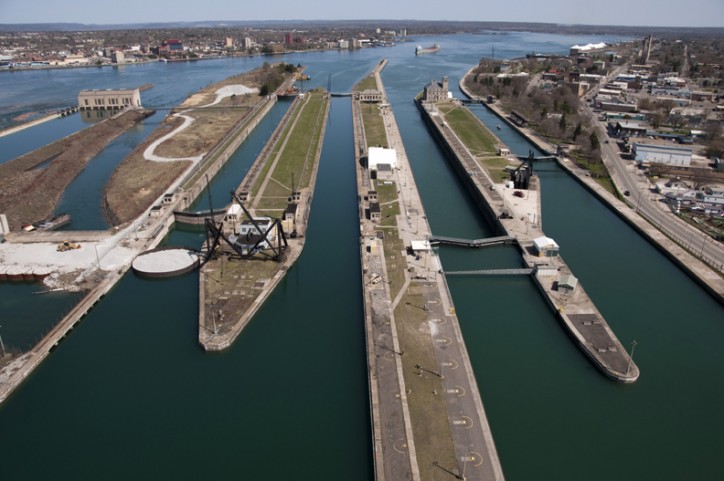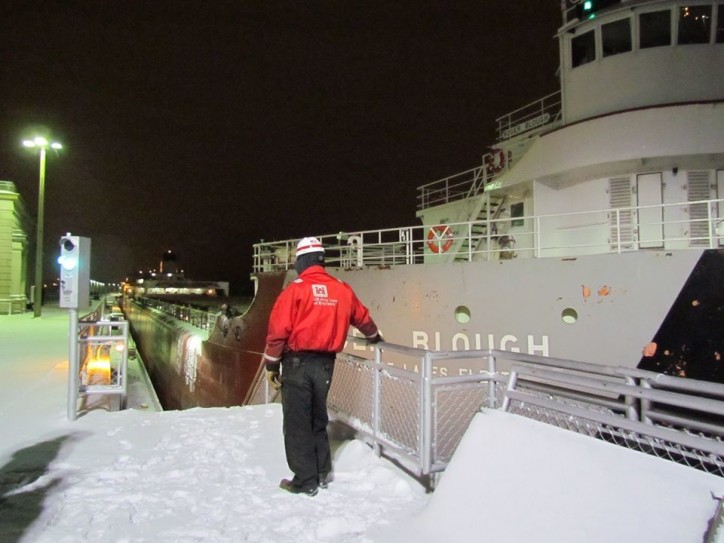At 12:01 a.m. LT on Friday (Mar 25), the U.S. Army Corps of Engineers officially opened the Soo Locks for the start of the 2016 shipping season. The locks at Sault Ste. Marie, Michigan are among 16 locks that form the Great Lakes St. Lawrence Seaway navigation system which extends from Duluth, Minnesota to the Atlantic Ocean. Together these 16 locks lift or lower ships 600 feet – the height of a 60 story building.
Since the Soo Locks closed in January, the Corps has been busy executing winter maintenance, repair and rehabilitation projects. Projects included the installation of a hydraulic system for the Poe Lock; anchorage repairs and dewatering bulkhead coating replacement on the Poe Lock; and work on the MacArthur Lock’s electrical modernization. These improvements ensure the reliability of the waterway, and the safety of the vessels and crews who will transit the locks over the next nine months.

The location of the Soo Locks provides a critical infrastructure link for shipowners and ports on both sides of the border. As a gateway for commerce, the locks allow for the movement of essential raw materials to transit from Lake Superior to the lower Great Lakes. Four thousand commercial vessels transit the locks each year carrying more than 80 million tons of iron ore, low-sulfur coal, grain, limestone and breakbulk cargoes from or destined for domestic and foreign ports.
“The opening of the Soo Locks is, for us, the opening day of baseball,” said Vanta Coda, executive director of the Duluth Seaway Port Authority. “It’s the excitement of a new season – the anticipation of seeing ships underway and commerce flowing in and out of the Duluth-Superior Harbor beneath the iconic Lift Bridge. It also reminds the shipping community that another year has passed for our nation’s aging infrastructure, which highlights the need to protect the Soo by twinning the Poe Lock.”
“When it comes to first pour steel, this country’s stronghold is the Great Lakes basin,” added Coda. “The supply chain that provides those raw materials to the region’s steel mills is a model of efficiency. The need for redundancy – for building a new Poe Lock – is a simple, pragmatic equation. Why risk losing as many as 11 million jobs in the event of a shutdown? It is beyond time to renew assets at the Soo. Our transportation infrastructure is a silent engine for this nation’s entire economy.”
James H. I. Weakley, president of The Lake Carriers’ Association, agrees. “The opening of the Poe Lock means America can again flex its industrial muscles. Iron ore from Minnesota and Michigan and coal from the Powder River Basin will flow to steel mills and power plants and energize our economy. There is no more important navigation lock in North America and we must redouble our efforts to build a second Poe-sized lock.”

The bulker Roger Blough entered the Poe Lock kicking off the 2016 navigation season at the Soo Locks. (Courtesy USACE)
Mark Barker, president of The Interlake Steamship Company added, “We’re optimistic about the new shipping season. Interlake’s modernized fleet of nine self-unloading ships annually moves nearly 20 million tons of bulk cargo consisting of iron ore, coal, limestone and grain. We rely on the Soo Locks as a vital link to deliver for our customers who are strategically located throughout the Great Lakes region.”
Tim Heney, CEO of the Thunder Bay Port Authority, the largest grain export port on the Lakes, stated that the Soo Locks are important to the port since 100 percent of their trade moves through the locks down to the Welland Canal and out through the Seaway. “The majority of our grain leaves the Port on Lakers for transloading onto ocean vessels in Quebec destined for customers in Europe, the Middle East, Africa, and Latin America. We also load ocean vessels for direct export,” added Heney.
Steve Fisher, executive director of the American Great Lakes Ports Association said, “The Great Lakes Seaway System is a crucial link between the U.S. and Canada, and global markets. The ports, Seaway and shipping companies depend on an efficient system to move essential cargoes for their customers. The start of the shipping season is a welcome event – it means the economy is moving again. And that translates into jobs and revenue for the bi-national economies.”
The St. Lawrence Seaway opened on Monday, March 21 with a Top Hat ceremony welcoming the first ship into the system at the Welland Canal.
Source: AJoT